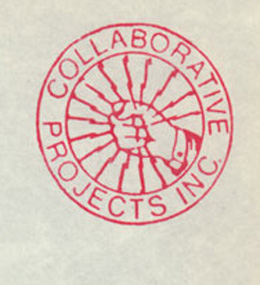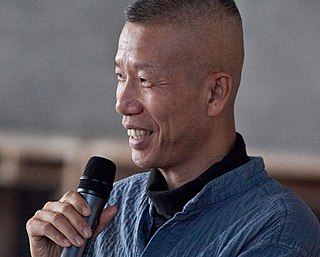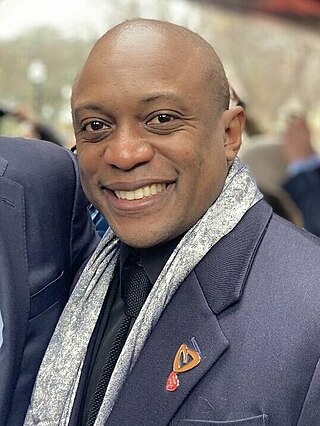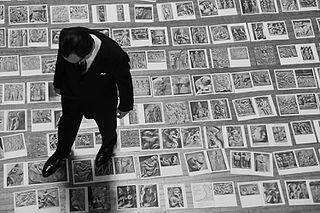Related Research Articles

The Kitchen is a non-profit, multi-disciplinary avant-garde performance and experimental art institution located at 512 West 19th Street, between Tenth and Eleventh Avenues in the Chelsea neighborhood of Manhattan, New York City. As the organization undergoes a multi-year renovation it is currently sited at a satellite loft space in the West Village located at 163B Bank Street, where exhibitions and performances are regularly held. It was founded in Greenwich Village in 1971 by Steina and Woody Vasulka, who were frustrated at the lack of an outlet for video art. The space takes its name from the original location, the kitchen of the Mercer Arts Center which was the only available place for the artists to screen their video pieces. Although first intended as a location for the exhibition of video art, The Kitchen soon expanded its mission to include other forms of art and performance, and incorporated as a not-for-profit arts organization in 1973. In 1974, The Kitchen relocated to a building at the corner of Wooster and Broome Streets in SoHo. In 1987 it moved to its current location in Manhattan, New York City.
Storefront for Art and Architecture is an independent, non-profit art and architecture organization located in SoHo, Manhattan in New York City. The organization is committed to the advancement of innovative positions in architecture, art and design.

Amy Sillman is a New York-based visual artist, known for process-based paintings that move between abstraction and figuration, and engage nontraditional media including animation, zines and installation. Her work draws upon art historical tropes, particularly postwar American gestural painting, as both influences and foils; she engages feminist critiques of the discourses of mastery, genius and power in order to introduce qualities such as humor, awkwardness, self-deprecation, affect and doubt into her practice. Profiles in The New York Times, ARTnews, Frieze, and Interview, characterize Sillman as championing "the relevance of painting" and "a reinvigorated mode of abstraction reclaiming the potency of active brushwork and visible gestures." Critic Phyllis Tuchman described Sillman as "an inventive abstractionist" whose "messy, multivalent, lively" art "reframes long-held notions regarding the look and emotional character of abstraction."

Colab is the commonly used abbreviation of the New York City artists' group Collaborative Projects, which was formed after a series of open meetings between artists of various disciplines.

Joan Mitchell was an American artist who worked primarily in painting and printmaking, and also used pastel and made other works on paper. She was an active participant in the New York School of artists in the 1950s. A native of Chicago, she is associated with the American abstract expressionist movement, even though she lived in France for much of her career.

The Getty Research Institute (GRI), located at the Getty Center in Los Angeles, California, is "dedicated to furthering knowledge and advancing understanding of the visual arts".

Cai Guo-Qiang is a Chinese artist.

Hank Willis Thomas is an American conceptual artist. Based in Brooklyn, New York, he works primarily with themes related to identity, history, and popular culture.
Irving Sandler was an American art critic, art historian, and educator. He provided numerous first hand accounts of American art, beginning with abstract expressionism in the 1950s. He also managed the Tanager Gallery downtown and co-ordinated the New York Artists Club of the New York School from 1955 to its demise in 1962 as well as documenting numerous conversations at the Cedar Street Tavern and other art venues. Al Held named him, "Our Boswell of the New York scene," and Frank O'Hara immortalized him as the "balayeur des artistes" because of Sandler's constant presence and habit of taking notes at art world events. Sandler saw himself as an impartial observer of this period, as opposed to polemical advocates such as Clement Greenberg and Harold Rosenberg.

Dennis Adams is an American artist. He has made urban interventions and museum installations that reveal historical and political undercurrents in photography, cinema, public space and architecture.
"Where We At" Black Women Artists, Inc. (WWA) was a collective of Black women artists affiliated with the Black Arts Movement of the 1960s and 1970s. It included artists such as Dindga McCannon, Kay Brown, Faith Ringgold, Carol Blank, Jerri Crooks, Charlotte Kâ (Richardson), and Gylbert Coker. Where We At was formed in the spring of 1971, in the wake of an exhibition of the same name organized by 14 Black women artists at the Acts of Art Gallery in Greenwich Village. Themes such as the unity of the Black family, Black female independence and embodiment, Black male-female relationships, contemporary social conditions, and African traditions were central to the work of the WWA artists. The group was intended to serve as a source of empowerment for African-American women, providing a means for them to control their self-representation and to explore issues of Black women's sensibility and aesthetics. Like AfriCobra, a Chicago-based Black Arts group, the WWA was active in fostering art within the African-American community and used it as a tool of awareness and liberation. The group organized workshops in schools, jails and prisons, hospitals, and cultural centers, as well as art classes for youth in their communities.
Claire Pentecost is an American artist, a writer, and Professor in the Department of Photography at the School of the Art Institute of Chicago, Chicago, Illinois. Her interdisciplinary practice interrogates the imaginative and institutional structures that organize divisions of knowledge, often focusing on nature and artificiality. Her work positions artistic practice as a research practice, advocating for the role of the amateur in the collection, interpretation, and mobilization of information. Her current projects focus on industrial and bioengineered agriculture, and the hidden costs of the global corporate food system.
Cindy Heller Nemser was an American art historian and writer. Founder and editor of the Feminist Art Journal, she was an activist and prominent figure in the feminist art movement and was best known for her writing on the work of women artists such as Eva Hesse, Alice Neel, and Louise Nevelson.
Leslie Labowitz-Starus is an American performance artist and urban farmer based in Los Angeles.
The Monya Rowe Gallery is a contemporary art gallery in New York City owned and curated by Monya Rowe.
Daniel Joel Tull is a contemporary American painter, sculptor and musician who lives and works in Los Angeles.
Bahc Yiso, also known as Mo Bahc, was a South Korean visual artist, cultural organizer, curator, theorist, and educator.

Teststrip was an artist run gallery that operated in Auckland, New Zealand from 1992 to 1997.
Adam Simon is an American art writer and conceptual painter. His works often feature stock photography, corporate logos, historical art images. According to Hyperallergic, he uses paint rollers, acrylics, and Mylar stencils to make silhouetted and overlapping paintings of images.

Rodriguez Calero is a New York artist working as a painter, collagist, and photographer.
References
- 1 2 Alternative histories : New York art spaces, 1960 to 2010. Rosati, Lauren, Staniszewski, Mary Anne. Cambridge, Massachusetts: MIT Press. 2012. ISBN 978-0-262-01796-1. OCLC 778075028.
{{cite book}}: CS1 maint: others (link) - ↑ Carey, Brainard (March 14, 2019). "Adam Simon". Praxis Yale Radio WYBC.
- ↑ Pentecost, Claire (1994). "Four Walls: Ten Years". Documents. 2: 4–10 – via Getty Research Institute, BHA.
- ↑ McNeil, Donald G. Jr. (1995-07-01). "Barney Simon, 63, Producer; Used Art to Fight Apartheid". The New York Times. ISSN 0362-4331 . Retrieved 2020-05-12.
- 1 2 Fensterstock, Ann (17 September 2013). Art on the Block : Tracking the New York Art World from Soho to the Bowery, Bushwick and Beyond (First ed.). New York, NY. p. 141. ISBN 978-1-137-36473-9. OCLC 887286569.
{{cite book}}: CS1 maint: location missing publisher (link) - ↑ Alternative Art, New York, 1965–1985 : A Cultural Politics Book for the Social Text Collective. Ault, Julie., Social Text Collective., Drawing Center (New York, N.Y.). New York: Drawing Center. 2002. p. 71. ISBN 0-8166-3793-8. OCLC 50253087.
{{cite book}}: CS1 maint: others (link) - ↑ Carey, Brainard, (March 14, 2019), Adam Simon, Praxis Yale Radio WYBC, Min 4 - 5.
- ↑ Pentecost,, Claire (1994). "Four Walls: Ten Years". Documents. 2: p. 4-6, via Getty Research Institute, BHA.
- ↑ Carey, Brainard. (March 14, 2019), Adam Simon, Praxis Yale Radio WYBC, Min. 8 - 9.
- 1 2 Four Walls at White Columns [ permanent dead link ], White Columns Archive, November, 1988.
- ↑ Pentecost,, Claire (1994). "Four Walls: Ten Years". Documents. 2: p. 6-7, via Getty Research Institute, BHA.
- ↑ Alternative Art, New York, 1965-1985 : A Cultural Politics Book for the Social Text Collective. Ault, Julie., Social Text Collective., Drawing Center (New York, N.Y.). New York: Drawing Center. 2002. p. 72. ISBN 0-8166-3793-8. OCLC 50253087.
- ↑ Bui, Phong (2006-04-10). "Amy Sillman with Phong Bui". The Brooklyn Rail. Retrieved 2020-05-12.
- 1 2 Alternative Histories : New York Art Spaces, 1960 to 2010. Rosati, Lauren, Staniszewski, Mary Anne. MIT Press. 2012. ISBN 978-0-262-01796-1. OCLC 778075028.
{{cite book}}: CS1 maint: others (link) - ↑ Szabo, Julia (1996-09-01). "The Do-It-Yourself Art World". The New York Times. ISSN 0362-4331 . Retrieved 2020-05-12.
- ↑ Smith, Roberta (1997-12-12). "Art in Review". The New York Times. ISSN 0362-4331 . Retrieved 2020-05-12.
- ↑ Pentecost, Claire (1994). "Four Walls: Ten Years". Documents. 2: p. 7, via Getty Research Institute, BHA.
- ↑ Tam, Herb (2012). Alternative Histories : New York Art Spaces, 1960 to 2010. Rosati, Lauren, Staniszewski, Mary Anne. MIT Press. pp. 85–86. ISBN 978-0-262-01796-1. OCLC 778075028.
- 1 2 Pentecost, Claire (1994). "Four Walls: Ten Years". Documents. 2: p. 5, – via Getty Research Institute, BHA.
- ↑ Tam, Herb (2012). Alternative Histories : New York art Spaces, 1960 to 2010. Rosati, Lauren, Staniszewski, Mary Anne. MIT Press. p. 85. ISBN 978-0-262-01796-1. OCLC 778075028.
- ↑ "Clocktower - Radio". clocktower.org. Retrieved 2020-05-13.
- ↑ "Studio 10". www.studio10bogart.com. Retrieved 2020-05-13.
- ↑ "Brooklyn Museum: Film and Music: "Michael Ballou's Super 8s"". www.brooklynmuseum.org. Retrieved 2020-05-13.
- ↑ Tam, Herb (2012). Alternative histories : New York Art Spaces, 1960 to 2010. Rosati, Lauren, Staniszewski, Mary Anne. MIT Press. p. 86. ISBN 978-0-262-01796-1. OCLC 778075028.
- ↑ "7 Rooms/7 Shows | MoMA". The Museum of Modern Art. Retrieved 2020-05-13.
- 1 2 Smith, Roberta (1993-01-08). "Art in Review". The New York Times. ISSN 0362-4331 . Retrieved 2020-05-13.
- ↑ Pentecost, Claire (1994). Four Walls: Ten Years. Documents. 2: p. 9, via Getty Research Institute, BHA.
- ↑ Smith, Roberta (1995-07-28). "Art in Review". The New York Times. ISSN 0362-4331 . Retrieved 2020-05-13.
- ↑ "Other Rooms". feldmangallery.com. Retrieved 2020-05-16.
- ↑ Winkler, Hans (1997). "Niemandsland". www.hswinkler.de. Retrieved 2020-05-13.
- ↑ Get together - Kunst als Teamwork [... erscheint zur Ausstellung Get Together - Kunst als Teamwork, Kunsthalle Wien, 8.10.1999-9.1.2000]. Bianchi, Paolo, Kunsthalle Wien, Ausstellung Get Together - Kunst als Teamwork 1999 - 2000 Wien, Ausstellung "Get Together - Kunst als Teamwork" 1999.10.08-2000.01.09 Wien. Wien: Folio Verl. 1999. ISBN 3-85247-022-6. OCLC 845331870.
{{cite book}}: CS1 maint: others (link) - ↑ Volk, Gregory, Big Brash Borough, Art in America, September, 2004, p. 93.
- ↑ Sexton, Joe (1997-06-07). "Tenants Fear Rent and Welfare Changes Spell Eviction". The New York Times. ISSN 0362-4331 . Retrieved 2020-05-14.
- ↑ Fensterstock, Ann (2013). Art on the Block : Tracking the New York Art World from Soho to the Bowery, Bushwick and Beyond (First ed.). New York, NY: St. Martin's Press. pp. 133–136. ISBN 978-1-137-36473-9. OCLC 887286569.
- ↑ Pentecost, Claire (1994). Four Walls: Ten Years. Documents. 2: p. 5, via Getty Research Institute, BHA.
- ↑ Corwin, Will, (2010) Michael Ballou, Clock Tower Radio
- ↑ Ault, Julie (2002). Alternative Art, New York, 1965–1985 : A Cultural Politics Book for the Social Text Collective. Ault, Julie., Social Text Collective., Drawing Center (New York, N.Y.). New York: Drawing Center. pp. 1–16. ISBN 0-8166-3793-8. OCLC 50253087.